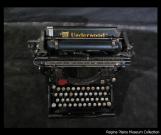1
Modes of Communication2
Damage to the Knox Presbyterian Church, located at 12th Avenue and Cornwall Street.1912
12th Avenue and Lorne Street, Regina Saskatchewan
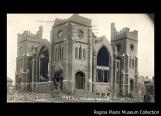
3
A disaster hits. Flood, earthquake, blizzard, tornado... any kind of disaster. What would you do? Grab your cell phone to call your loved ones? Turn on the news to find out what is going on? In today's world of instantaneous global communication, it is difficult to imagine a time when information wasn't so readily at hand.5
On June 30th, 1912 the only hint that anything was wrong in Regina was a desperate telegraph, sent to Winnpeg that read "Cyclone struck Regina, 16.50k. City in ruins." You can imagine the panic and confusion this short message must have caused. Yet, this was the most efficient and one of the fastest forms of communication available in 1912. Telegraph messages were expensive to send, and were usually reserved for businesses, government and newspapers. While telephones existed, they were not yet common - never mind that the Regina Telephone Exchange Building had been destroyed in the storm - and most people had to settle for word of mouth or a letter or postcard sent in the mail.6
The Regina Post Office building just after it was completed in 1906.1906
11th Avenue and Scarth Street, Regina, Saskatchewan
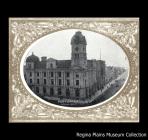
7
Postal workers in the Paymaster's office of the Regina Post Office building.1912
12th Avenue and Scarth Street, Regina, Saskatchewan

8
Postal workers at the Regina Post Office.1912
12th Avenue and Cornwall Street, Regina, Saskatchewan
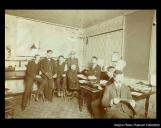
9
The amount of tornado-related mail must have been overwhelming. Postal workers were likely kept busy for months dealing with every nature of inquiry. Fortunately, Regina's new Post Office, having just been completed in 1906 and left undamaged by the storm, was up to the task.Immediately following the tornado, personal inquiries poured into the city. For many, the only way to discover the fate of friends and family was to pen a letter to the Regina Postmaster, or to the Mayor himself.
10
City Clerk A.W. Pool's reply to an inquiry, with another reply on the bottom.July, 1912
Regina, Saskatchewan
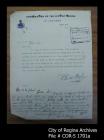
11
These letters were generally forwarded to the City Clerk who, with his staff, composed and typed responses to a variety of inquiries as they arrived. In 1912, the City Clerk was A.W. Pool. There are hundreds of replies with Mr. Pool's signature at the bottom.Occasionally, Mr. Pool was the bearer of bad news, confirming the identities of those killed in the tornado. More often, replies were sent out with the assurance that the names of those being inquired about would be placed in a newspaper ad, with instructions to contact Mr. Pool to confirm their wellbeing.
12
Postcards were used as quick notes to reassure relatives that all had survived the tornado.July, 1912
Regina, Saskatchewan
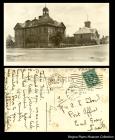
13
As the citizens of Regina began to recover from the tragedy, personal mail began to trickle out of the city as well. Postcards often served as a quick note to assure anxious relations. This postcard, with an image of the Regina High School reads:"Dear Murel,
Pleased to say we are all safe, letter following later. Guess Ted wouldn't know Regina now simply terrible. Love to you all.
Yours affect. Elsie"
14
Correspondence from the Main family, describing one woman's experience with the tornado.July, 1913
Regina, Saskatchewan

